Claregalway Castle
Houses within 10km of this house
Displaying 30 houses.
Houses within 10km of Claregalway Castle
Displaying 30 houses.
| House name | Description | |
|---|---|---|
| Mervue/Merview | Built circa 1777 by the Joyces. In 1786 Wilson refers to a house near Galway as the seat of Dr. "Joice". The house was sold by them to Royal Tara China in 1953. This company occupied the building for over 50 years, closing down at the end of 2003, though the shop premises still operates from this building. A fire badly damaged the original building in 1957. |

|
| Merlin Park | A house on the outskirts of Galway, built by Charles Blake in the first decade of the 19th century. Bought by Henry Hodgson in the Encumbered Estates' Court in 1852. It was held in fee by him at the time of Griffith's Valuation and valued at £65. Merlin Park was purchased by the Waithman family in 1876 and in their ownership until 1945. Thereafter it was compulsorily acquired for the building of a TB sanitorium. The house no longer exists and Merlin Park Hospital now occupies the site. |

|
| Renmore House | The residence of Patrick Marcus Lynch and his descendants on the outskirts of Galway from the early 19th century, leased from the Governors of the Erasmus Smith Schools. It was valued at £35 at the time of Griffith's Valuation. The house was sold circa 1924 and became a tuberculosis sanitorium. It is now part of a Health Service facility. |
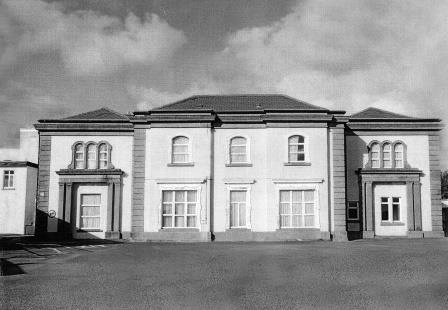
|
| Wellpark | In 1786 Wilson refers to Wellpark as the seat of Mr. French. It became a residence of the MacNamara family early in the 19th century. In 1855 occupied by Martin Morris and by George Morris in the 1870s. The home of the Moffett family in the early 20th century. Frances Moffett wrote the book ''I also am of Ireland'' published by the British Broadcasting Corporation, London, 1985. The house, which was in a derelict condition, was demolished in 2007. | |
| Winterfield House | Described in the 1830s as a neat 2 storied house, the home of Captain Butler. It was held in fee by John Butler at the time of Griffith's Valuation, when it was valued at £15. It is no longer extant. | |
| Derrymaclaughna | A house appears to be located near the castle on the first Ordnance Survey map of 1838. The Ordnance Survey Name Books mention the ruins of a castle, a mansion house and a chapel in the townland. The property belonged to the Burke family in the 18th century as Wilson noted it as the seat of Mr. Burke in 1786. It became the residence of Thomas P. O'Flahertie of the Lemonfield family in the early 19th century. He was married to a daughter of Ulick Burke of Derrymaclaughna. At the time of Griffith's Valuation it was occupied by Thomas Cullinane who held it from James Browne. Derrymaclaughna was the residence of Alan Parker Close in the 1870s. In November 1887, Richard Rowland was offering for sale a quarter share of the lands at Errew, county Mayo, as well as lands at Derrymacloughna, barony of Clare, county Galway, in the Land Judges' Court. However, due to absence of bidding, the sale was adjourned. |

|
| Cregg Castle | Built in the mid 17th century, the home of the Kirwans until the early 19th century. In 1786 Wilson mentions that it was the last castle to be built in county Galway and that it had lately been remodelled by Mr. Kirwan. Later occupied by a branch of the Blake family. It was held in fee by Francis Blake at the time of Griffith's Valuation, when it was valued at £40. Slater notes it as the residence of Mrs. Blake in 1894. Sold by the Blakes in 1947 to the Johnstons, who made alterations and restored it. Bought by the Murrays in the early 1970s, who ran it as a guest house. Sold again in 2006. |

|
| Baunmore | Held in fee by Richard Kirwan at the time of Griffith's Valuation when it was valued at £7. The house was extended and enlarged towards the end of the nineteenth century. It as well as yard buildings, gates and walls still remain. |

|
| Murroogh House | Part of the Blake estate at Merlin Park. Built by James Henry Ryan in the 1860s who spent nearly £5,000 on the property and occupied in the 1880s by the Bishop of Galway. Owned by the newspaper magnate William Randolph Hearst in the 1930s and bought by the Galway Mayo Institute of Technology in 2003. |
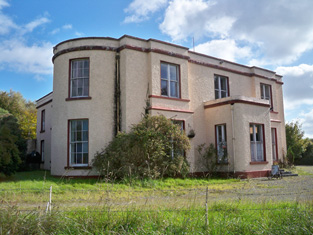
|
| Castle Lambert | Castle Lambert was built in the later 18th century. At the time of Griffith's Valuation it was owned by Walter Lambert and was valued at £20. It is no longer extant, only the bell tower in the yard remains. |

|
| Moor Park | Occupied by Giles Eyre Lambert at the time of Griffith's Valuation when he was leasing it from Walter Lambert. It was valued at £20. Later the seat of Frank Shawe Taylor who was assassinated nearby in 1920. There is still a large house at Moor Park though the National Inventory of Architectural Heritage indicates that this is not the original house. |
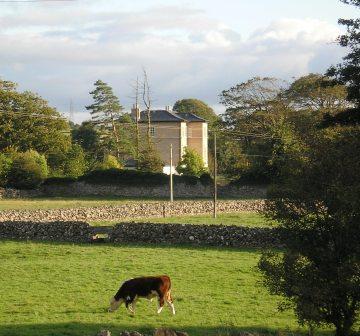
|
| Waterdale | This was originally a Staunton property which passed by marriage to the Lamberts. In 1786 Wilson refers to it as the seat of Mr. Staunton. The OS Name Books record it as the property of James Blake in the 1830s. Sold to Lord Clanmorris briefly in the 1850s and repurchased by James Staunton Lambert, Waterdale was leased to John Wilson Lynch 1857-1870 and to James Delahunt 1870-1883. It was taken over by the Land Commission in 1903 and demolished. |

|
| Annaghdown | A house at this site on the First Edition Ordnance map is labelled Annaghdown House. The current house was built in 1868 by the Blake family It is still occupied and well maintained. |

|
| Rockwood | John Galway is recorded as the owner of Rockwood at the time of Griffith's Valuation when it was valued at £20. In 1906 Rockwood House was owned by Robert W. Holmes and valued at £20. It was occupied by the Holmes family until after WWI. It was later the property of the Fox family. It was restored in the mid-1980s and is now extant and occupied. |

|
| Rocklawn | The OS Name Books give the name of this house as Rockland and state that it was the residence of the Browne family though they claim that the townland of Pollaghrevagh was the property of Lord Clanmorris. At the time of Griffith's Valuation it was occupied by James French and was valued at £12. By 1906 it was owned by Richard French. Rocklawn House is no longer extant. It is described as "in ruins" on the 1933 printing of the 6" OS sheet for Galway. |

|
| Carnmore | The OS Name Books record Mr. Blake of county Mayo as the proprietor of Carnmore in the 1830s. At the time of Griffith's Valuation Valentine O'Connor Blake was leasing a house valued at £4 and over 100 acres to Arthur Veitch. Some ruins remain at the site. | |
| Lydacan | Lydacan or Lydican Castle was a residence of the Lynch family in the 1770s. The OS Name Books record the "substantial residence of Mr. Gunning" in Lydacan in the 1830s. Lydacan Castle was purchased by Martin O'Flaherty in the mid-19th century and was subsequently sold by him to James Greated. It was burnt in 1922 and the ruins remain. |

|
| Thornpark | At the time of Griffith's Valuation the property at Carrowmoneash, parish of Oranmore, was leased by the representatives of H. Butler to Anne Butler/K.H. Blake. Burke's Landed Gentry (1958) states that Xaverius Henry Blake Butler purchased Thornpark, part of his mother's dowry, in the Landed Estates' Court in April 1860. Sir Henry Blackall states that Xaverius Blake Butler bought Mount Vernon, which he renamed Thornpark, from his nephew Henry.By 1906 the house at Carrowmoneash was owned by James Blake Butler and was valued at £26. Thornpark House is now the Oranmore Lodge Hotel. See www.oranmorelodge.ie for more information. |

|
| Frenchfort | Frenchfort became a Blake property in 1780 when Michael Blake married Anne Ffrench of Frenchfort. Wilson mentions the house as his seat in 1786. He is described as a resident proprietor in 1824. At the time of Griffith's Valuation the house at Frenchfort in the parish of Oranmore was occupied by his grandson, Theobald Blake. The original house does not appear to be present now but the walled garden layout is still visible. |
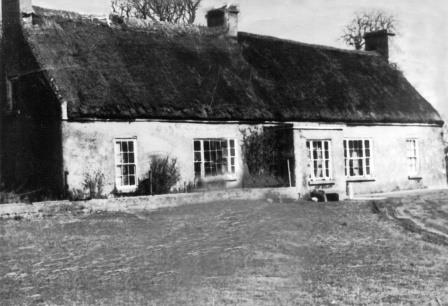
|
| Oranbeg | At the time of Griffith's Valuation the property at Oranbeg was leased by the Fitzgerald Vesey estate to George Hill and valued at £8. It is labelled Vesey Lodge on the 25-inch Ordnance Survey map of the 1890s. It is no longer extant. | |
| Rocklands (Oranmore) | Rocklands was occupied by George Ingham in the 1850s when it was valued at £13. In 1906 it is recorded as the property of Isabella Ussher and was still valued at £13. The house is still extant and occupied. |
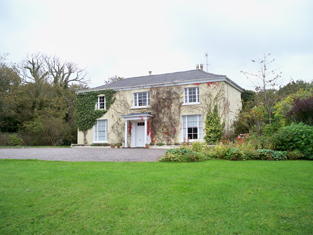
|
| Oran Castle | In 1786 Wilson mentions Oranmore as the seat of Denis Blake. In 1814 and again in 1837 Oranmore Castle is recorded as the seat of Walter Blake. At the time of Griffith's Valuation he was leasing a property, valued at £10, in Oranmore townland, to Martin Grady. Pádraig Lane writes that Walter Blake sold Oran Castle to James Dillon Meldon. The castle was refurbished by the King family in the twentieth century. |

|
| Coolaran | Sometimes spelt Coolarne. At the time of Griffith's Valuation, the Meldon estate owned a herd's house at Coolarne. Later the property became a convent of the Sisters of the Sacred Heart. It is now an addiction treatment centre. |
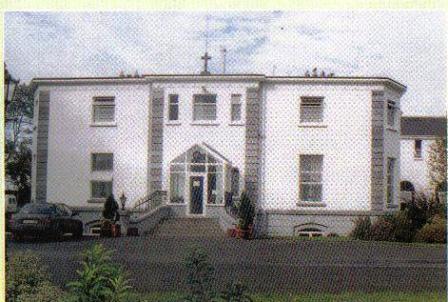
|
| Woodpark | Described in the sale rental of 1879 as "a good house, with stables, a walled garden, walled orchard and a park around the house which stands on an elevated site affording a fine view of lake scenery". Peter Newell was occupying the house, then valued at £4, at the time of Griffith's Valuation. It is now a ruin. |

|
| Cloonacauneen Castle | Muriel L. Athy writes that the castle was occupied by Martin Blake in 1835, although it is recorded in the Ordnance Survey Name Books as the property of Mr. French. The property later passed into the hands of Mr Fair "who built against it a Tudor house", his descendant Dr Fair of Ballinasloe sold it to the Estates Commissioners". Owned by James Malley in the early 20th century. Described by Bence Jones as a tower house with an attached wing. Still occupied, it now operates as a bar and restaurant. |

|
| Rockhill House | The earlier house at Rockhill was the residence of Daniel Higgins in 1814. At the time of Griffith's Valuation, it was occupied by Dominick D'Arcy and was valued at £9. A new house appears to have been built in the latter half of the nineteenth century and, in the 1870s, it was the seat of Lionel D'Arcy. Rockhill is stil extand and well-maintained. |
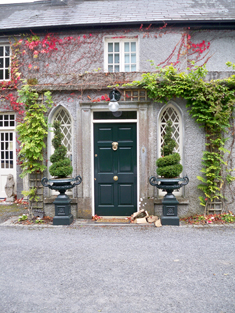
|
| Killeen House & Killeen Castle (Oranmore) | In 1814 Killeen Castle is recorded as the home of Marcus Blake. By the time of Griffith's Valuation it was used by the Cullinane family who lived at Killeen House nearby. The latter property was valued at £10 at the time of Griffith's Valuation. The castle and its adjacent buildings afterwards fell into ruin but was restored in the later twentieth century and is now occupied once again. Killeen House was demolished in the twentieth century. | |
| Carrowbrowne Castle | In 1786 Wilson refers to Carrowbrowne as the seat of Mr. Blake. This may refer to Walter Blake as family history records suggest some of his children were born at Carrowbrowne. The castle is shown and labelled on the 1st edition Ordnance Survey map of 1842. The townland is part of Lord Oranmore and Browne's estate at the time of Griffith's Valuation. By the time of the 25-inch edition of the 1890s it is shown as "in ruins". Some ruins still remain at the site. | |
| Angliham | In 1786 Wilson refers to "Anglngiham" as the seat of Mr. Bateman. The Ordnance Survey Name Books indicate that the townland of Angliham or Gortacallow, in the parish of Oranmore, was the property of Thomas Bateman of Altavilla, Rathkeale, county Limerick. The description mentions that the townland contained the ruins of an old building " formerly the residence of Mr. Bateman's ancestor". | |
| Corbally House (Kilmoylan) | In 1786 Wilson refers to Corbally, the seat of Mr. D'Arcy, situated beside a lough. This would appear to be Corbally House, in the parish of Kilmoylan. By the time of Griffith's Valuation, the townland was in the possession of James O'Hara and Walter Blake was occupying this property which was valued at £2. It is no longer extant. |

